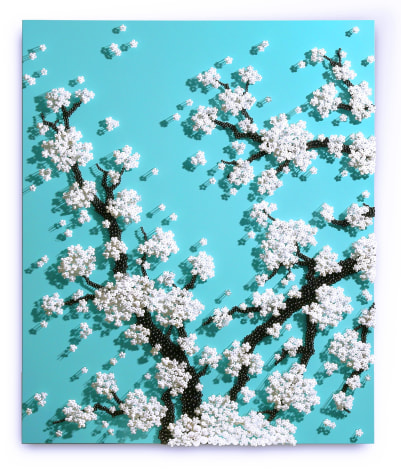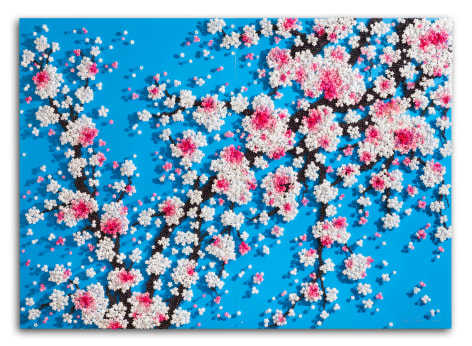
Ran Hwang
Healing Forest, 2018,
Buttons, Beads, Pins on Wooden panel
H47.2in x W39.3in / H120cm x W100cm

Ran Hwang
Healing Forest, 2018,
Buttons, Beads, Pins on Wooden panel
H67in x W93in / H170cm x W236cm

Ran Hwang
Becoming Again, 2018,
Paper Buttons, Beads, Crystals, Pins on Plexiglas, Wooden Frame
H94.4in x W71in / H240cm x W180cm
We are pleased to announce the first solo exhibition in the UAE of contemporary Korean artist Ran Hwang, titled The Flight of Time at Leila Heller Gallery in Dubai, opening September 18th and on view through November 7, 2019. Hwang’s show coincides with the opening of the Dubai Opera House and the unveiling of her Chandelier work, the largest of the series to date. Featuring both established and more recent works by Hwang, The Flight of Time further explores the themes encompassing the artist’s career, including emphasis on the relationship between observing the cyclical nature of life and taking part in it. The show epitomizes the overarching theme in the artist’s work very well, as each series deals with the idea of time in some way: the Plum Blossom series symbolizing the ephemerality of life, and the Buddha series and Temple series imply the vanity of short-lived power and subjectivity of time.
Hwang has transcended the meaning of “everyday use,” as she employs materials such as paper buttons to create intricate yet powerful depictions of natural beauty. Her work is both conceptual and practical, as she engages with Zen Buddhist ideology of repetition through the execution of her artistic process. Ran Hwang finds tranquility through these meditative principles. She transforms the pins as they are hammered to Plexiglas panels, just as she does when weaving thread. Hwang utilizes concentration, patience, and dedication as she creates these works- all in an effort to celebrate the transience of this very practice.
Hwang’s Korean heritage as well as her experience living and working in the United States influence her art-making. Hwang’s earlier career began in the fashion industry at an embroidery design studio in the garment district. While there, she discovered boxes of unused buttons, and was struck by the lack of attention they received. Later on, at her studio in Dumbo, Hwang would observe the twin towers collapse during 9/11 from her own window. This left a great impression on her, leading her to contemplate ideas of collectivity, life, death, and rebirth that would translate in her work for years to come.
Hwang has since focused on the material as a key role in the product. She explores her cross-cultural experience within her work with the use of mass-produced materials that elevate and shape into the natural understanding of the world. Her work transcends “women’s work,” and redefines “craft”- as she discovers the fluidity in construction, rethinking what it means for a mechanism to be employed within the setting of the work. Iconic Buddhist imagery of birds, temples, and cherry blossoms are all juxtaposed with the indistinguishable element found within buttons, creating an aesthetic non other than her own.
The show, inspired by one of the most famous works of 19th-century British literature of Edward Fitzgerald's translation of "The Rubaiyat of Omar Khayyam," draws upon the long series of four-line verses by a 12th-century Persian mathematician and astronomer. Hwang’s work is built around the idea of time, ephemerality, transience, disappearance. Flight and ephemerality are very well-established themes in such poetry, which is full of references to passing time and the urgency to seize beauty in the present moment.
ABOUT THE ARTIST
Ran Hwang has exhibited at several international institutions including the Hermitage Museum & Gardens, Virginia; Hermes Foundation, Singapore; Brooklyn Msuseum, New York; Queens Museum of Art, New York; The Hudson Valley Center for the Arts, New York; MASS MoCA, Massachusetts; Asian Civilization Museum, Singapore; Palais des Beaux Arts, Brussels (forthcoming); and The Seoul Arts Center Museum. Hwang’s work is also a part of numerous private and public collections including The Dubai Opera, Dubai; The Brooklyn Museum, New York; The Des Moines Center for the Arts, Iowa; The National Museum of Contemporary Art, Seoul; The Hammond Museum, North Salem, NY; Museum of Fine Arts, Houston; UNESCO Paris Headquarters; and New York University.